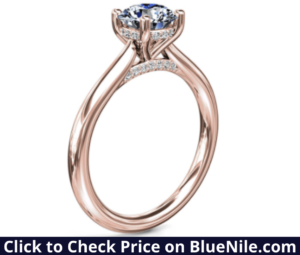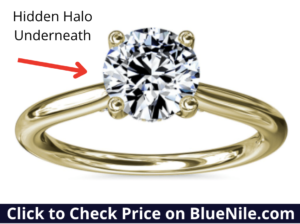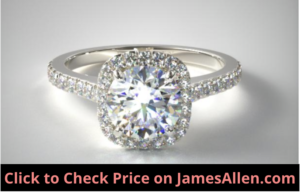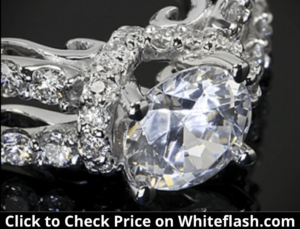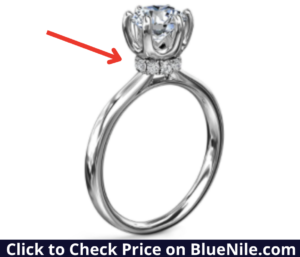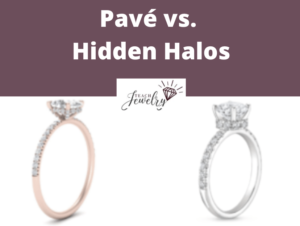
There’s more to consider when searching for a ring than the diamond on top. Beyond the diamond’s cut quality or carat weight, its setting enhances the overall appeal.
Two customizations to a setting are pavé wraps and hidden halos.
The main difference between pavé wraps and hidden halos is that pavé wraps include small diamonds placed on the prongs or parts of the ring that hold the diamond. Hidden halos are small circles of accents below the main diamond. Both add brilliance and a higher total carat weight to the ring.
We’ll compare pavé wraps versus hidden halos, including an overview of each, three differences, their similarities, and how to decide between them.
What is a Pavé Wrap Setting?
A pavé wrap is a feature on diamond rings where pavé diamonds are placed along the shank on the parts of the ring that grasp the diamond.
In the example below, notice how the pavé wrap forms a V-shape when viewed from the front and back.
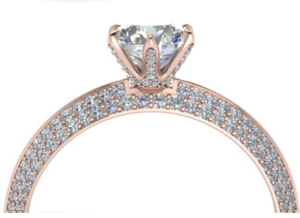
In most cases, three to six prongs hold a diamond against its setting. The traditional style is to leave the metal on prongs exposed.
Pavé wraps use this space for more diamonds.
They line the prongs and extend toward the area where the tips secure the crown. Depending on length, there could be anywhere from three to six gems lining each prong.
For example, this pavé wrap knife edge ring has six diamonds on each prong.
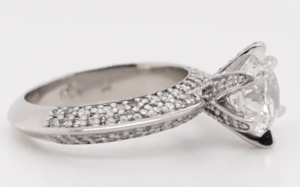
Two sit side-by-side at the base, and four are stacked on top.
Similar to the first example of a pavé wrap, there are two rows of diamonds cascading halfway down each side of the band.
But the design isn’t always referring to accents on prongs. In other cases, the setting also wraps around the diamond.
Pavé diamonds are placed on this wrap, so the diamond is encapsulated with even more sparkle.
It’s possible for pavé wraps to fit any diamond, whether it’s a cushion, radiant, or emerald cut, but the style is most commonly associated with round ones.
What is a Hidden Halo Setting?
A hidden halo is a small circle of diamonds at the base of the setting.
The reason it’s called a hidden halo is it can’t be seen from the top-down view.
Instead, it’s most visible from the profile, like in the image below.
Halos of every type are a popular customization for pieces of jewelry. It refers to adding a ring of small diamonds that complement or blend in with the main one.
They’re typically used as a way to increase the apparent size of the main diamond in a way that avoids the price premium of increasing its carat weight.
A unique trait of hidden halos is the diamonds are placed facing sideways.
For example, this ring from James Allen, where I purchased my wife’s engagement ring, includes a hidden halo.
When viewing it from the profile, you’ll notice the diamond’s tables are facing toward you. They’re tucked under the crown of the center gem.
If you rotate the image on the vendor’s website and view it from the front, the halo almost disappears.
Hidden halos aren’t specific to any diamond cut. They can be placed under any fancy shape, including pear, marquise, and oval cuts.
In fact, some buyers choose hidden halos for cuts that don’t exhibit as much brilliance. Step-cuts like emerald and Asscher diamonds have a softer, warm glow as opposed to the strong scintillation of brilliant cuts.
The sparkle from hidden halos compensates for this shortcoming. You’ll have the cut of your choosing without sacrificing all the light performance.
What are the Differences Between Pavé Wraps and Hidden Halos?
1. Hidden Halos are Only Visible From the Side View
Hidden halos are visible when you’re looking at the ring’s profile. To illustrate, the engagement ring below has the diamond facing toward you, and the halo isn’t visible.
You might wonder why someone would pay extra for a customization that isn’t always visible.
There are two reasons.
The first reason is hidden halos cause the main diamond to appear larger. Gemologists estimate the center stone looks 15 percent bigger if there’s a halo at its base. there’s a higher amount of sparkle to create that effect.
The second reason is hidden halos don’t detract from the center diamond. It’s the most valuable part of the ring, so many buyers want it to stand alone.
Features like traditional halos and side stones may add brilliance, but they steal attention from the main diamond.
Take the engagement ring below.
It’s a stunning center diamond, but your eyes are also drawn toward the classic halo and pavé designs.
Pavé wraps are almost always visible from every angle. Even if the wrap is only on prongs, the accents are noticeable from each direction.
If the pavé wrap is on a wider part of the shank that circles the diamond, you can’t hide it no matter how it’s viewed. This is a pro and con.
It distracts from an exceptional center gem and causes it to blend in with the pavé wrap, but if your center diamond is smaller or has a lower cut grade, it can improve its aesthetic appeal.
There’s no right or wrong design. It’s a matter of preference and is why I recommend viewing each setting in person or through a high-quality image.
2. Pavé Wraps Often Include More Diamonds
Pavé wraps often include a higher number of diamonds because there’s more room on the ring to cover.
If there are six prongs, that’s six positions on the ring to line with diamonds.
If it’s a full wrap around the diamond, there could be between 10 and 16 total gems.
As an example, let’s check out this pavé wrap diamond engagement ring from Whiteflash.
Its pavé wrap forms a V on two sides of the main stone. On the other two sides, there appear to be multiple pavé diamonds.
The total carat weight of the setting 0.95, but that includes the accents lining the rest of this type of ring shank.
What distinguishes this design from other pavé wraps is there are no gems on the prongs. Other designs add an even higher carat weight by placing them along the thin claws.
Hidden halos, on the other hand, often include four to nine diamonds.
For example, this ring appears to have eight gems.
You can view them at each angle by rotating the image on the seller’s site.
The total carat weight is 0.07, which means each pavé diamond is incredibly small.
The higher number of accents on a pavé wrap means more potential maintenance. Even if you choose a high-quality setting, these gems are liable to loosen, fall out, or trap debris.
They’re more difficult to clean and can catch on furniture, clothing, or hair during everyday wear.
These issues are less likely with hidden halos because the halo is positioned under the diamond and protected by it. It’s less susceptible to hits and drops, but your main diamond is still exposed.
3. Hidden Halos Require a Higher Setting
Another decision buyers make is whether to choose a high or low set engagement ring. A high setting, like its name implies, positions the diamond far above the top of the ring.
A low setting places it closer.
The main advantage of a high setting is it allows the diamond to collect more light and exhibit strong brilliance. If you choose a large diamond and want it prominently displayed, choose a high setting.
Hidden halos often require a high setting because you need room for the halo to wrap around the band.
This is because some designs place the halo around the diamond’s culet, like this ring.
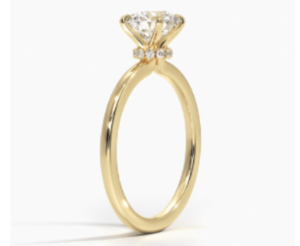
Others place the halo closer to the diamond’s crown.
If it were positioned any higher, it would likely become visible and make the setting a traditional halo.
If you choose a high setting for your hidden halo, it may also minimize the gap between the engagement ring and wedding ring. The wedding ring can fit against the band, under the main diamond.
Pavé wraps aren’t as affected by whether it’s a high or low setting.
But if it’s a high setting, you can typically include more diamonds because the prongs are longer as they stretch to grasp the gem.
This is also true if the pavé wrap is circling the whole diamond.
What are the Similarities?
Brilliance
The first quality they have in common is both add brilliance to the ring.
Light performance is one of the most coveted traits for a diamond ring, but increasing the carat weight or cut grade is expensive.
Avoid a significant price increase by instead adding pavé diamonds to the ring in the form of a pavé wrap or hidden halo. Both enhance the ring’s sparkle.
Price
The designs are also priced higher than a solitaire setting. The reason a halo or pavé setting costs more than a solitaire setting is because of extra diamonds and added effort to place them.
But the increase in cost often doesn’t compare to adding the equivalent carat weight to the center gem.
For example, this solitaire setting made with 18k white gold costs $830.
This ring is similar but has a double hidden halo that totals 0.16 carats.
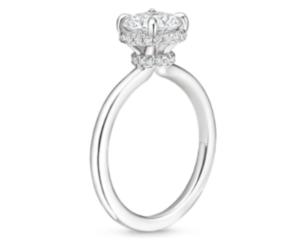
It’s priced at $1,490, which is a difference of $660.
If you were to add 0.16 carats to a single diamond, it would often cost far more than $600.
Fit on the Same Ring
The last similarity between hidden halo and pavé wraps is you don’t have to choose one or the other. They can exist on the same ring.
The most common style is for the prongs to feature pavé diamonds and a hidden halo to wrap around the main diamond’s culet.
They use the same cut and size of diamonds, so the two designs complement each other when they appear to intersect.
How to Decide Between Pavé Wraps and Hidden Halos
Deciding on a pavé wrap versus hidden halo requires understanding the benefits and drawbacks of both customizations.
Here are some tips to help you choose.
Opt for a pavé wrap if:
- You want extra diamonds visible from all angles
- You’re interested in exploring a variety of designs and all the ways pavé diamonds and other gemstones encircle the center stone
- The center diamond on your ring is small or doesn’t have strong brilliance, and you want to increase the piece’s sparkle
Consider hidden halo settings if:
- You aren’t concerned the halo won’t be visible from the top-down view
- You want to increase the apparent size of your main diamond
- A diamond ring with a high setting is appealing
But you don’t have to decide between one or the other. Your ring can have both.
By combining several diamond cuts with pavé wraps and hidden halos, you’ll land on the right ring for you.

Jacob Clarke
Jacob Clarke is the founder of TeachJewelry.com.
He earned an Applied Jewelry Professional Diploma from the Gemological Institute of America (GIA) and now brings you essential information about diamonds, settings, and more.
Jacob has consulted with leading jewelry brands, and his work has been cited in Clean Origin, Diamond Nexus and industry publications.
He's also a member of the International Gem Society.
He enjoys discussing jewelry with readers, so contact him with any questions at jacob.clarke@teachjewelry.com.

